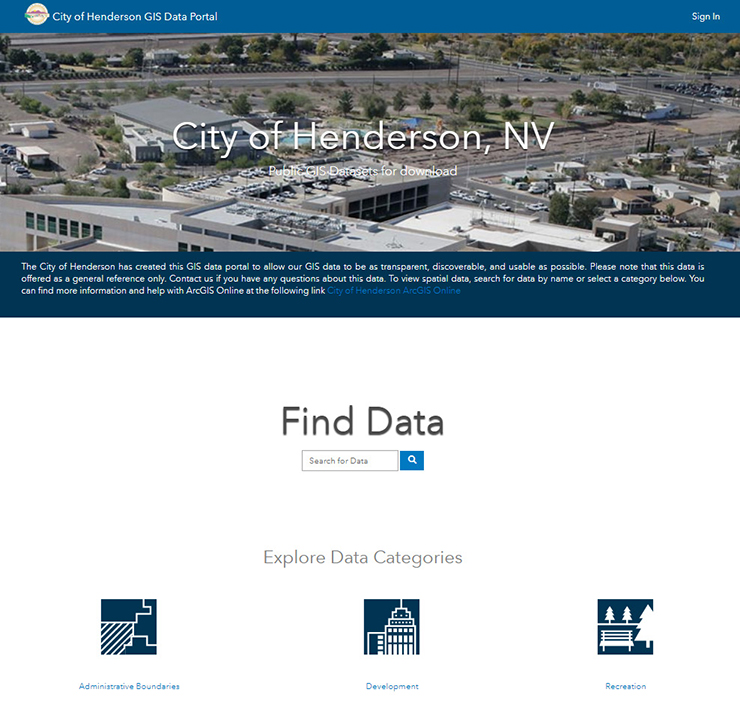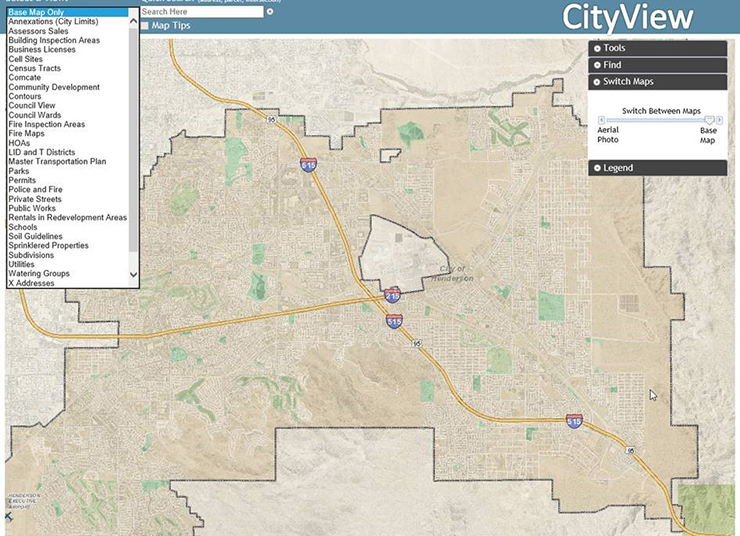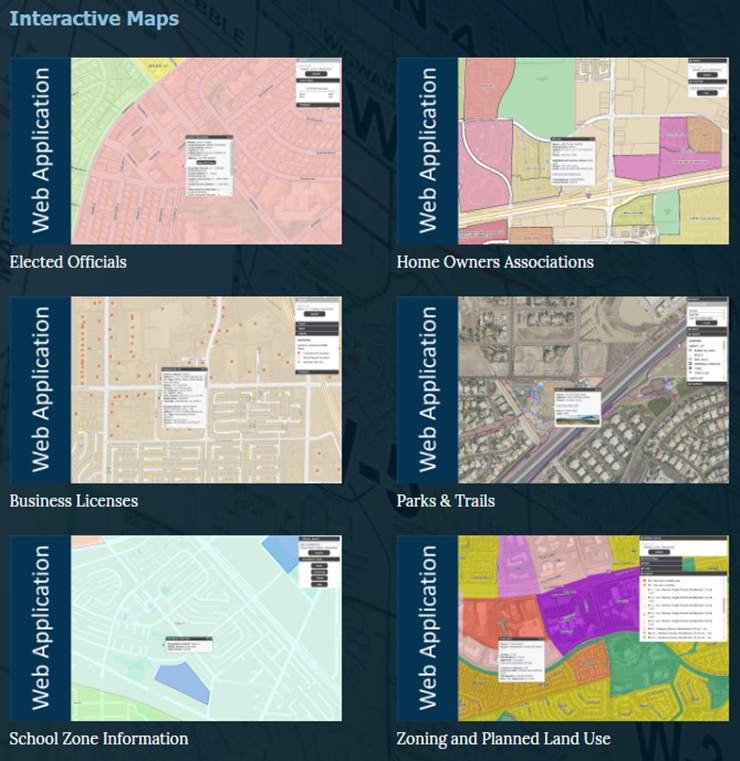Henderson Shares the Power of GIS with its Constituents
The city of Henderson, Nevada, boasts a small-town atmosphere even though it is Nevada’s second-largest city with more than 310,000 residents. Forbes named Henderson the second-safest city in America and MONEY magazine put it on the list of Best Places to Live in America three times.
Henderson’s safe, small-town feel comes from the city government’s devotion to making Henderson a great place to live and visit. From events, parades, parks, and planned communities to the celebration of local businesses’ grand openings and youth accomplishments, Henderson prioritizes providing value to everyone there.
One of the most valuable things a city can provide its citizens is information, and in this digital age, information is everywhere. Data has the ability to make significant, positive impacts on communities and citizens — the key is knowing how to use it. In many cases, the use of powerful data is limited to “experts:” those who know how to access and utilize information to discover trends and insights.
Perhaps Henderson’s greatest contribution to its community is the recognition that data is best utilized by those it impacts the most, not just experts. That understanding has translated into the city updating processes without retraining or hiring new staff, custom applications being built by the people who want them, and those applications receiving thousands of unique page views monthly.
GIS Recognition
Along with the recognition Henderson received from Forbes and MONEY magazine, the city was also presented with a 2017 Special Achievement in GIS (SAG) award from Esri®, the leading provider of geographic information system (GIS) mapping software. GIS is an important tool for local governments because it provides precise, real-time location data that can be used by everyone from emergency response teams to permitting and maintenance departments. The adoption of GIS technology within local governments eliminates the need for printed or hand-drawn maps, making location data more accurate and reliable. This enhances the government’s recordkeeping as well as the upkeep of property and assets and the protection of citizens.
Henderson stands out from more than 100,000 organizations in the GIS world because of an addressing project it worked on to eliminate manual data maintenance and allow addresses to be input into ArcGIS®, Esri’s GIS database, by non-GIS staff. The use of ArcGIS by non-GIS staff was important to Henderson because it allowed the city to implement new, more advanced software without drastically changing the internal processes that were already in place.
Henderson was one of only 175 organizations selected in 2017 to win the coveted SAG award.
This recognition led to Henderson exploring more advanced uses of GIS technology, like creating custom internal and public-facing GIS applications. The city was even able to put the ability to create these applications in the hands of various subject matter experts instead of relying on its IT department for development. Because of the city’s efforts with GIS, Henderson’s data has become more transparent to its citizens, thus allowing them to become safer and more informed.
Previous Processes
Before this award-winning addressing project, Henderson had a planner who would enter addresses into its permitting software, rather than ArcGIS. Those addresses then had to be processed and converted into GIS data via nightly scripts. The city’s GIS staff maintained this address data through nightly CSV exports from its permitting system. Additionally, address changes and updates were sent to the county in a flat file format via nightly scripts.
When the city found out its permitting system would no longer be supported, it began the search for a new solution. Because the permitting system Henderson decided to implement required address files to be in a spatial format rather than flat files, Henderson GIS staff seized the opportunity to innovate their operations and update their technology while the new system was being implemented.
“We knew that it needed to be managed in GIS, and we didn’t want to have to train non-GIS people and buy ArcGIS licenses,” said Tommie Weckesser, Henderson’s GIS coordinator.
These needs led the city to search for and implement a GIS solution that:
- Allowed the planner to continue inputting address data
- Allowed the planner to input that data into ArcGIS without having to be familiar with GIS
- Upgraded the data maintenance and update processes from running scripts to using web services
Henderson used multiple solutions that work in conjunction to fulfill these needs.
An Innovative Approach to Address Data
Henderson was eager to update its processes, but it didn’t need to change everything. The city was no stranger to Esri tools; its arsenal already included the following:
- ArcGIS for Server: a tool allowing organizations to share GIS resources as web services
- ArcGIS Desktop: a mapping and analytics platform
- ArcGIS Online: a cloud-based mapping platform
- ArcGIS Open Data: a tool that allows entities to find public data and set up public-facing websites to share the data
- Collector for ArcGIS: a mobile mapping application for field workers
- Operations Dashboard for ArcGIS: a configurable web application that allows entities to view dynamic data and analytics in real time
On top of the above Esri tools, Henderson enlisted the help of an IT consulting company, Bradshaw Consulting, to implement a new product called The Addresser. This tool extended the base functionality of Henderson’s ArcGIS database, allowing the planner to continue managing address data without learning GIS.
While Henderson’s new permitting system was being implemented, staff worked tirelessly to clean up address data. They used Python scripts and SQL queries to compare data to multiple sources (street centerlines, parcels, old address system data, etc.). This cleanup allowed Henderson GIS staff to come up with a variety of address data sources to compare, validate, and verify.
Once the new permitting system went live, Henderson had established the exact GIS data process it set out to create:
-
One that allows a planner with no prior GIS knowledge to input address information in the ArcGIS environment, allowing the city to maintain its previous address input process while reaping the benefits of advanced GIS technology
-
One that updates address data with web services instead of nightly scripts, eliminating tedious, manual data maintenance
Address Data Is Just the Beginning
Through the success of its addressing project and its status as a SAG award winner, Henderson has established itself as a leader, innovator, and trailblazer in the GIS world. Naturally, the city wasn’t going to stop at the addressing project. Henderson’s GIS staff is dedicated to furthering their use of GIS to continue providing more value to the city. The city’s next GIS project included the creation of custom applications for various departments.

GIS data portal
Henderson leverages ArcGIS Online in a way that puts power in various users’ hands, limiting the burden on IT to develop custom applications for each use case. Just like with the addressing project, the city has found great success with this initiative, evidenced by its 17 public-facing applications and its public-facing GIS data portal, which takes information from its internal application, CityView, built to collect GIS data from all departments.

Internal application
We have GIS staff in our utilities department, public works department, community development, police, fire, and IT. So, what we wanted to do is be able to give our power users the ability to create their own applications,
Tommie Weckesser
Henderson’s GIS Coordinator
Of the 17 public-facing applications, the top five most used are Crime Search, Watering Groups, Zoning, Sex Offenders, and Home Owners Associations.
These applications received 4,600 unique page views in May 2018, alone.

Public-facing applications
Additionally, CityView has 220 users and usage grows by approximately 25 percent each year.
Weckesser said, “That was a big win for us: getting our users to be able to make their own applications and use some of the technology.”
What’s Next
It’s clear Henderson is not going to stop its GIS innovation any time soon. Currently, the city is interested in exploring ArcGIS Enterprise, which includes ArcGIS Server, a portal, data storage, and a web adaptor, and would essentially be an upgrade from its existing ArcGIS Desktop and ArcGIS Online environments.
“It seems like more of their newer stuff you’re going to have to have portal, so I’m sure that that’s a road that we’re going to go down,” said Weckesser.
Whatever technology the city implements, one thing is certain: Henderson will continue to lead the way in full utilization of GIS resources for local government operations. The city’s GIS staff works hard to ensure they not only have the latest and greatest technology, but are utilizing it in the most logical, efficient, and impactful ways.